The Tales of Xadia RPG, taking place in the world of the Dragon Prince Netflix show, was announced by Fandom RPG in July last year. To my everlasting relief and delight, it does not use the Dungeons & Dragons rules but rather the Cortex Prime ruleset, which is known for being more of a toolkit to build systems on than a fully-fledged game.
I wasn’t quite sure what to expect, admittedly, as my experience with the system had been very limited until recently, and none of it practical. With the release of the playtest rules for Tales of Xadia, this could change. And since there’s nothing like putting a system through some paces when it comes to judging it, I opted to play a brief session using it.
Theory
Let’s start at the beginning, though. How does Cortex Prime work and how does Tales of Xadia use it? The principles behind it might take some getting used to for players used to more traditional games, but I will do my best to shed some light on them.
Characters in Tales of Xadia are built using a collection of traits. These are Attributes, Values, Distinctions, Specialties, and Assets. Each of them has a die value, from d4 to d12. These form the core of our character’s capabilities. The game illustrates them by creating a character sheet (or journal, as it’s called here) for Rayla.
Attributes are more or less what you would expect: Strength, Spirit, Intellect, Influence, Awareness and Agility. No surprises here, except perhaps for Influence. It’s simply the game’s version of a “persuasion” trait. You use it when trying to convince, coerce or otherwise get people to do or see things your way.
Values are more unusual and the part where Cortex Prime’s system assumptions come into play. They represent the character’s beliefs, priorities and inner nature. They are Devotion, Glory, Justice, Liberty, Mastery, and Truth. They work like attributes in that their value can vary from d4 to d12. Rayla has a d10 rating in Devotion – she’ll push herself hard to help those she cares about. Her Glory, on the other hand, is d4 – she cares little about recognition, fame and accolades.
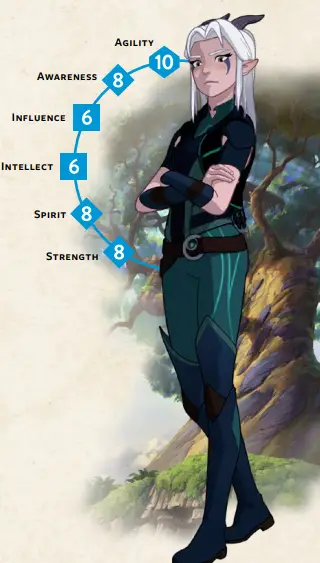
Distinctions are another distinct element of Cortex Prime and Tales of Xadia. They are essentially your character’s defining traits. They represent their background, accomplishments, peculiar features, or vocation. Every Distinction has a d8 value to start with and enables you to use one or more special effects.
Rayla’s Distinctions are Moonshadow Elf, Reluctant Assassin, and Act First, Think Later. The first one obviously refers to her people and enables her to use their preternatural agility and power to vanish in moonlight. The second one refers both to her training and the doubts that plague her. The third one of course encapsulates her impulsiveness. They do not have any special abilities beyond the basic one (more on it below).
Specialties are the closest this game has to what we’d call skills; they’re particular areas of expertise that will aid you if they come up. For Rayla, it means Sneaking, Swordplay, and Tracking. Assets, finally, are external sources of aid. They can be items, people, or creatures. Rayla naturally has her elven butterfly blades, which are both a weapon and a climbing tool.
Alright, you might be asking, but how does it all come together? It does so in a way that’s both simple and fairly complex at first. Traits are combined into a dice pool. Every time a character attempts something that requires a roll, they add up an attribute, a value, a distinction, and anything else that applies – those three are traits that always come into play.
That distinctions always apply is something that confuses me somewhat. Would any of Rayla’s Distinctions help her in a negotiation, for instance? Or trying to decipher a coded message? Perhaps I’m missing something. Specialties and Assets do only come up if they logically apply to a situation. The dice pool may also include the opposition’s stress dice (more on that below) and special effects from your distinctions.
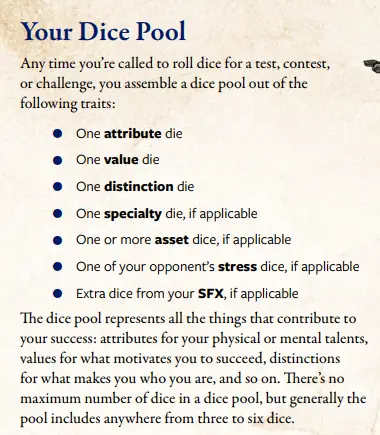
One way or the other, we put all these dice together and we roll. But unlike with other dice pools, we don’t add the numbers up and count successes. Instead, we pick two dice as our outcome and one as our effect die.
The outcome determines whether or not we beat the test at all. The difficulty of any given test depends on the exact type of it – test, contest, or challenge. Tests are simple actions, contests happen when we directly contend with an NPC and challenges are an extended back-and-forth representing a more involved struggle or attempt. Contests stand out because they involve NPCs’ traits, rather than an abstract difficulty.
In a simple test, the GM rolls two dice and their sum determines the outcome we need to beat. Thus we roll our dice pool and pick two dice that, added together, equal or beat what the GM rolled. We also pick one die as the effect die – it determines how efficiently we succeed. It doesn’t matter as much in a simple test, but more so in a contest or challenge. Unlike with outcomes, the number rolled on the effect die doesn’t matter – only its size does.
Players and GMs can manipulate the odds by using Plot points, or PP. They’re earned and spent in play. If a player rolls a one on a die in their pool, the GM can give them a PP to “activate” it and increase the challenge of a roll. Players can also give in after failing to beat the difficulty in a contest (but not a normal test) or step down their distinction die in a pool to a d4.
PP they earn this way can be spent in a variety of ways to improve their odds of success – add temporary asset dice, include more results in your outcome and more. They’re also necessary to activate special effects of distinctions. For instance, if Rayla wishes to make use of her innate Moonshadow Elf traits, she has to spend one. If she does, she can make her Agility die one step higher in a roll, which isn’t normally possible with PP.
One final thing I should mention before sharing our experience with actually playing the game is stress. Tales of Xadia has no hit points, health levels, or wounds. Instead, hardships and obstacles inflict several kinds of stress: Afraid, Angry, Anxious, Corrupted, Exhausted, and Injured. As you can see, only two of these are physical and only one is caused by direct damage. By default, player characters take stress when they fail at tests, contests, and challenges. Other circumstances may inflict stress as well.
Like other traits, stress comes in the form of dice. It starts at “0”, then goes up to d12. Once it gets past that, the character is traumatized, which is more serious. Stress hinders a character and is added to the opposition’s dice pools if appropriate. This applies to PCs and NPCs alike.
Practice
That’s enough dry theory, however. How did Tales of Xadia play? It was an interesting experience, to be sure. Neither me nor my players had a lot of experience with fiction-driven RPGs such as Cortex, being used to more traditional games.
The adventure presented to us by the playtest is called Lost Oasis. The player characters are hired by a Moonshadow elf mage called Feathershawl to retrieve an object called the Primal Well from an abandoned floating Skywind Elf city.
The city has been isolated for generations and is now on collision course with the mountains along the border between Xadia and the human lands. Feathershawl wants to retrieve the Well before it’s lost in the catastrophe. Needless to say, once the party gets there, it turns out things aren’t quite as they appear and the players have bigger problems on their hands than a simple retrieval.
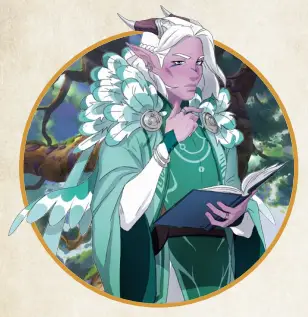
Lost Oasis comes with a selection of pre-generated characters. Three humans and three elves – the adventure takes place after the third season of The Dragon Prince, so relations between humans and elves are not quite as bad as they used to be. The human characters are Diyan, a Durenian soldier, and his best friend Vinaya, a noble of the same kingdom. Their more recent acquaintance is Winda, a Del Baran huntress. The elves are represented by Eljaal, a Moonshadow assassin in a similar predicament as Rayla – though in fairness, it’s not their fault that their target died in an accident before they could kill him. Bineta and Babukar are a pair of Sunfire siblings, a knight and a wizard respectively.
While we don’t have proper character-building rules yet, these sheets give us a better look at what characters look like in the system. Eljaal has the same Moonshadow Elf distinction as Rayla, while the Sunfire siblings share an innate power – they can willingly take on Angry stress to increase their strength and agility. The humans have no such magic, but they get distinctions based on their background – Durenian Freefolk, Durenian Noble, and Del Baran Hinterlander.
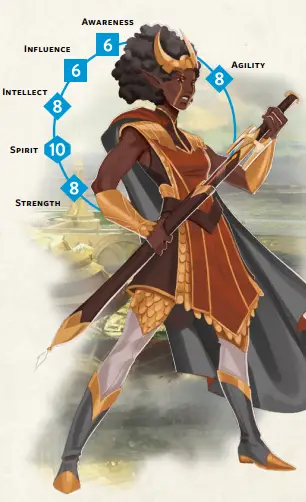
Babukar is also our look into how magic works in the system. He has the distinction of a Hotheaded Sun Mage, a specialty in Sun Magic and three spells, which work as assets. The primer mentions dark magic, but without much detail. We do know that using dark magic inflicts the special Corrupted stress.
My three players picked Vinaya, Bineta, and Eljaal as their characters. How did the game go? Well… a lot of it was spent on the growing pains of using a new system. I also learned that running a pre-made adventure is a lot harder than it looks. But we did manage to glean some insights into this system.
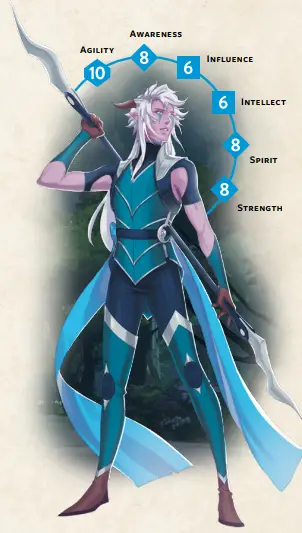
To start with, the basic mechanic seems to have quite a lot of variance to it. A good dice pool can still roll poorly. This can be mitigated by using plot points to add extra dice to them or pick one more die after rolling and eke out a few more points. Of course, PP run out, which encourages players to generate them by downgrading their distinction dice and accepting defeat.
The intended result seems to be a back and forth where players escalate situations and accept consequences in order to be able to succeed where it counts.
Assembling dice pools seems to be a bit of an art, as players can play to their strengths by trying to apply their attributes, values, and distinctions. That said, we made a mistake while playing and thought that distinctions don’t always apply. Thus the players’ dice pools weren’t as high as they could be. In contests, having to pick out an effect die added an extra layer to the decision-making.
We didn’t really have time to go through the entire adventure, but we did make some rolls. We didn’t notice that every failed roll is supposed to give stress. Of course, our goal was to make as many rolls as possible to bite into the system.
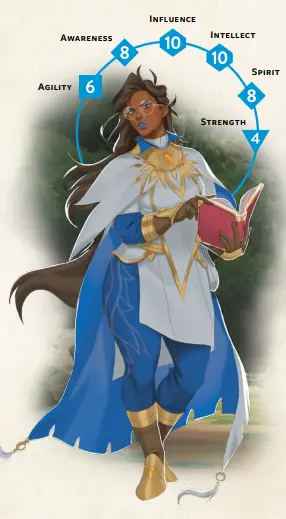
What we didn’t do was test out “giving in” in terms of contests. In a contest initiated by a PC, they roll first, and then the NPC has to beat their result. If they do manage it, the PC can try to beat their total or give in and receive a PP. Since the players managed to win the contests they initiated, this didn’t come up.
Despite our early struggles, I think I can see how the mechanics can come together into a dynamic, fast-flowing action that simulates the drama of a story.
Unfortunately, we weren’t able to cover challenges. They are the most mechanics-intensive type of test, where players need to make multiple rolls in order to wear down a difficulty set by the GM. Effect dice play a major part in such a struggle. This can be a pitched battle, an attempt to get into a secure vault… any challenge that the GM decides need to take more time and tension.
While I wish I’d been able to experience more of Tales of Xadia, what I saw of it is quite promising. It looks to be a narrative-focused game with some rules heft to it, but without getting focused on details of character management. Rather, its mechanics serve the purpose of facilitating dramatic action. I’m curious to see where it leads when we see the final version.
Images courtesy of Fandom and Wonderstorm
Have strong thoughts about this piece you need to share? Or maybe there’s something else on your mind you’re wanting to talk about with fellow Fandomentals? Head on over to our Community server to join in the conversation!

